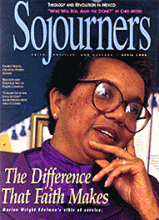Culture Watch
An Invitation to Life
Sankofa's truth will set you free.
By Calvin Morris

The word of the Lord that came to Joel son of Pethuel:
Hear this, O elders, give ear, all inhabitants of the Land!
Has such a thing happened in your days, or in the days of your ancestors?
Tell your children of it, and let your children tell their children, and their children another generation.
Joel 1:1-3
Sankofa, directed by Ethiopian-born Howard University professor Haile Gerima, is a hauntingly beautiful, powerful, and disturbing film about Western slavery and its aftermath.
Beauty is created by the lush scenery of the unnamed Caribbean island where the action takes place and the visual attractiveness of the actors whose sepia, ebony, and cafe au lait tones grace the screen. Power is provided by the films ability to evoke in the viewer an awareness of the pain and hurt, rage and anguish, and guilt and shame long suppressed and unacknowledged. Distress is caused by the truth that it reveals, mocking the presumed innocence of Americas historical past.
Gerima, through Sankofaan akan word meaning "you must go back to go forward"endeavors to assist the film-going public in an unexpurgated exploration of the slave past through the eyes of the slaves themselves.
Read the Full Article
